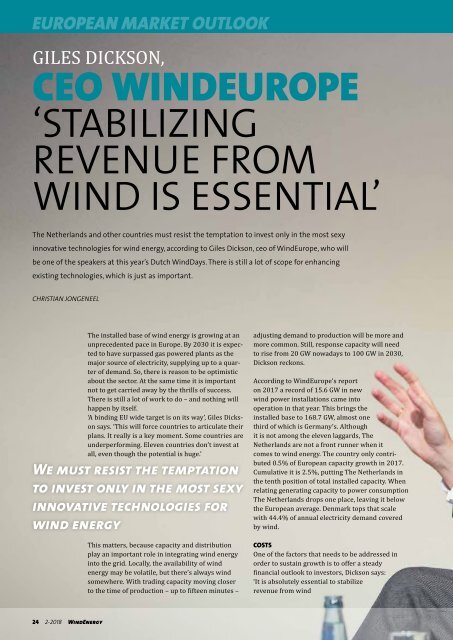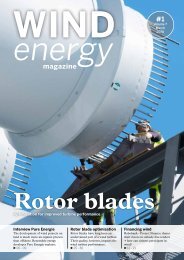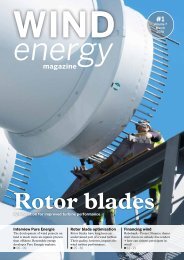WINDENERGY MAGAZINE 02 2018
Create successful ePaper yourself
Turn your PDF publications into a flip-book with our unique Google optimized e-Paper software.
EUROPEAN MARKET OUTLOOK<br />
WINDDAYS <strong>2018</strong><br />
GILES DICKSON,<br />
CEO WINDEUROPE<br />
‘STABILIZING<br />
REVENUE FROM<br />
WIND IS ESSENTIAL’<br />
The Netherlands and other countries must resist the temptation to invest only in the most sexy<br />
innovative technologies for wind energy, according to Giles Dickson, ceo of WindEurope, who will<br />
be one of the speakers at this year’s Dutch WindDays. There is still a lot of scope for enhancing<br />
existing technologies, which is just as important.<br />
CHRISTIAN JONGENEEL<br />
energy development. Governments are moving<br />
from subsidies to auctions to drive down costs.<br />
Recently we have seen auctions where no subsidy<br />
was required at all. That was certainly spectacular,<br />
but it is important to note that zero cannot be the<br />
norm. Only some developers in some countries<br />
can afford this, specifically in Germany and The<br />
Netherlands, because of their low capital costs and<br />
stable regulation.’<br />
In other words, government spending on wind<br />
energy infrastructure is not about to dwindle<br />
down. It will lower by itself, in any case, because a<br />
lot of money still goes to older facilities, that required<br />
higher subsidies. When these are phased out<br />
the effective subsidy per GW naturally diminishes.<br />
Actually, WindEurope’s annual report already<br />
shows this trend of lowering costs. Although 2017<br />
was a record breaking year for investments that<br />
were announced in terms of capacity for future<br />
projects (11.5 GW) the total investment was<br />
19% lower than in the previous year,<br />
when 10.3 GW reached its final investment<br />
decision. Striking, too, was the<br />
60% drop in investments in offshore<br />
wind, which had been rising for five<br />
years in a row. In contrast, onshore<br />
wind rebounded from a slowdown<br />
the year before.<br />
installing ever larger facilities in the North Sea,<br />
moreover, sparks the imagination. ‘We certainly<br />
will need even larger turbines that can cope<br />
with higher wind speeds’, Dickson acknowledges.<br />
‘Floating offshore wind farms are an interesting<br />
development, and everything that has to do with<br />
storage deserves attention. However, we must resist<br />
the temptation to invest only in the most sexy<br />
Wind energy will remain the<br />
dominant sustainable power<br />
source of the future<br />
innovative technologies for wind energy. There is<br />
a lot of existing technology that deserves attention,<br />
such as better components for wind turbines,<br />
which should lead to lower maintenance cost.’<br />
Even with these caveats the prospects<br />
for wind energy are sunny. As<br />
governments realise that<br />
wind turbines are cheaper<br />
than for instance pv installations,<br />
wind energy<br />
will remain the dominant<br />
sustainable power<br />
source of the future.<br />
The installed base of wind energy is growing at an<br />
unprecedented pace in Europe. By 2030 it is expected<br />
to have surpassed gas powered plants as the<br />
major source of electricity, supplying up to a quarter<br />
of demand. So, there is reason to be optimistic<br />
about the sector. At the same time it is important<br />
not to get carried away by the thrills of success.<br />
There is still a lot of work to do – and nothing will<br />
happen by itself.<br />
‘A binding EU wide target is on its way’, Giles Dickson<br />
says. ‘This will force countries to articulate their<br />
plans. It really is a key moment. Some countries are<br />
underperforming. Eleven countries don’t invest at<br />
all, even though the potential is huge.’<br />
We must resist the temptation<br />
to invest only in the most sexy<br />
innovative technologies for<br />
wind energy<br />
adjusting demand to production will be more and<br />
more common. Still, response capacity will need<br />
to rise from 20 GW nowadays to 100 GW in 2030,<br />
Dickson reckons.<br />
According to WindEurope’s report<br />
on 2017 a record of 15.6 GW in new<br />
wind power installations came into<br />
operation in that year. This brings the<br />
installed base to 168.7 GW, almost one<br />
third of which is Germany’s. Although<br />
it is not among the eleven laggards, The<br />
Netherlands are not a front runner when it<br />
comes to wind energy. The country only contributed<br />
0.5% of European capacity growth in 2017.<br />
Cumulative it is 2.5%, putting The Netherlands in<br />
the tenth position of total installed capacity. When<br />
relating generating capacity to power consumption<br />
The Netherlands drops one place, leaving it below<br />
the European average. Denmark tops that scale<br />
with 44.4% of annual electricity demand covered<br />
by wind.<br />
INNOVATION<br />
‘People, especially in The Netherlands,<br />
are inclined to look mainly at<br />
offshore wind for growth’, Dickson<br />
comments. ‘However, most growth is<br />
onshore and this will remain so. Witness<br />
for instance the recent commitments Akzo,<br />
Philips and Google amongst others made in The<br />
Netherlands to onshore wind for powering<br />
their operations.’<br />
Nevertheless, a focus on offshore wind<br />
is understandable in a country with<br />
a high population density, resulting<br />
in frequent protests against new<br />
projects. The challenges of<br />
This matters, because capacity and distribution<br />
play an important role in integrating wind energy<br />
into the grid. Locally, the availability of wind<br />
energy may be volatile, but there’s always wind<br />
somewhere. With trading capacity moving closer<br />
to the time of production – up to fifteen minutes –<br />
COSTS<br />
One of the factors that needs to be addressed in<br />
order to sustain growth is to offer a steady<br />
financial outlook to investors, Dickson says:<br />
‘It is absolutely essential to stabilize<br />
revenue from wind<br />
Photo by WindEurope / Bickley<br />
24 2-<strong>2018</strong> WindEnergy<br />
WindEnergy 2-<strong>2018</strong> 25















